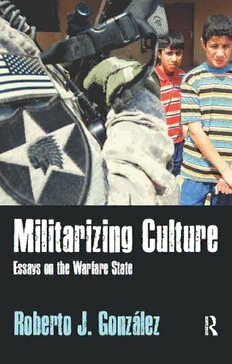
Militarizing Culture: Essays on the Warfare State PDF
Preview Militarizing Culture: Essays on the Warfare State
Militarizing Culture This page intentionally left blank Militarizing Culture Essays on the Warfare State Roberto J. González First published 2010 by Left Coast Press, Inc. Published 2016 by Routledge 2 Park Square, Milton Park, Abingdon, Oxon OX14 4RN 711 Third Avenue, New York, NY 10017, USA Routledge is an imprint of the Taylor & Francis Group, an informa business Copyright © 2010 Taylor & Francis All rights reserved. No part of this book may be reprinted or reproduced or utilised in any form or by any electronic, mechanical, or other means, now known or hereafter invented, including photocopying and recording, or in any information storage or r etrieval system, without permission in writing from the publishers. Notice: Product or corporate names may be trademarks or registered trademarks, and are used only for identification and explanation without intent to infringe. Library of Congress Cataloging-in-Publication Data González, Roberto J. (Roberto Jesús), 1969– Essays on the warfare state / Roberto J. González. p. cm. Includes bibliographical references and index. ISBN 978-1-59874-559-7 (hardcover : alk. paper) — ISBN 978-1-59874-560-3 (pbk. : alk. paper) — ISBN 978-1-59874-561-0 (eISBN) 1. United States—Civilization—21st century. 2. War and society—United States. 3. Popular culture—United States. 4. Afghan War, 2001—Social aspects—United States. 5. Iraq War, 2003—Social aspects—United States. I. Title. E169.12.G637 2010 303.6’60973—dc22 2010025902 An earlier version of chapter 3, “Towards Mercenary Anthropology?” was published in Anthropology Today 23, vol. 3: 14–19. Copyright © 2007 by the Royal Anthropological Institute, London. An earlier version of chapter 5, “Human Terrain,” was published in Anthropology Today 24, vol. 1: 21–26. Copyright © 2008 by the Royal Anthropological Institute, London. An earlier version of chapter 7, “Going ‘Tribal’,” was originally published in Anthropology Today 25, vol. 2: 15–19. Copyright © 2009 by the Royal Anthropological Institute, London. Figure 0.1: Copyright © 2009 by Sean M. Haffey/San Diego Union Tribune/ZUMA Press. Reprinted by permission. Figure 0.3: Copyright © 2010 by Terese Hart. Reprinted by permission. Figure 1.2: Copyright © 2008 by Trevor Paglen. Reprinted by permission. Figure 1.3: Copyright © 2010 by Heidi Stambuck. Reprinted by permission. Cover design by Allison Smith Cover illustration: Children of an Iraqi farmer watch as US soldiers conduct operations in the town of Aqur Quf (northwest of Baghdad) on March 29, 2010. (Photo courtesy of Manhea Kim/US Department of Defense.) ISBN 978-1-59874-559-7 hardcover ISBN 978-1-59874-560-3 paperback F R, K, J This page intentionally left blank Contents List of Illustrations 8 Acknowledgments 11 Introduction: Militarizing Culture 13 Part I: Basic Training Chapter 1 Spy Camp for Kids 35 Chapter 2 Shattered Taboo 57 Part II: Enlisting Culture Chapter 3 Towards Mercenary Anthropology? 77 Chapter 4 The Arab Mind and Abu Ghraib 95 Chapter 5 Human Terrain 111 Part III: Controlling Behavior Chapter 6 Counterinsurgency in the Colonies 135 Chapter 7 Going “Tribal” 153 Afterword: Decommissioning Culture 173 Glossary 181 References 183 Index 203 About the Author 209 Illustrations Figure 0.1 Justin Velázquez at an advance screening of GI Joe: The Rise of Cobra, August 2009. Figure 0.2 The military-industrial complex includes companies and organi- zations that have a symbiotic relationship with the Pentagon. Figure 0.3 Although the Mbuti are avid hunters, they are a non-warring society. Figure 1.1 Spy agencies are aggressively recruiting minority youth. Figure 1.2 A secret prison complex known as the Salt Pit near Kabul, Afghanistan. Figure 1.3 Junior high school students at a University of Arkansas summer program. Figure 2.1 The ancient technique of “waterboarding.” Figure 2.2 The cast of the hit television series 24. Figure 2.3 US military personnel guarding captives at Guantánamo Bay, 2002. Figure 3.1 David Kilcullen briefs US Army officers in Iraq, June 2007. Figure 3.2 British officers in Baghdad, circa 1932. Figure 3.3 Bradley assault vehicle produced by BAE Systems. Figure 4.1 Iraqi prisoner tortured by US military personnel at Abu Ghraib, November 2003. Figure 4.2 “The Snake Charmer” by Jean-Léon Gérôme. 8 I Figure 5.1 Human terrain team member speaks with Afghan men, June 2007. Figure 5.2 Black Panther Party member, circa 1970. Figure 5.3 Mapping the human terrain in Baghdad, Iraq. Figure 6.1 Filipino insurgents detained by US forces in Manila, circa 1901. Figure 6.2 Indigenous men from Pampanga province, Philippines, conscripted into a native constabulary by US colonial administrators, circa 1909. Figure 6.3 T. E. Lawrence (“Lawrence of Arabia”). Figure 7.1 Human terrain team members talk with a village elder in Afghanistan, August 2009. Figure 7.2 United States and Afghan officials consult with “tribal” elders and Islamic clergy in Khost, Afghanistan, September 2006. Figure 7.3 General David Petraeus testifies before Congress, September 11, 2007. Figure 7.4 US soldiers install a concrete separation barrier in Shula, Iraq, June 8, 2008. Figure 8.1 A US air raid on Karam, Afghanistan, severely injured these children on October 11, 2001. Figure 8.2 The video game America’s Army. M C 9
